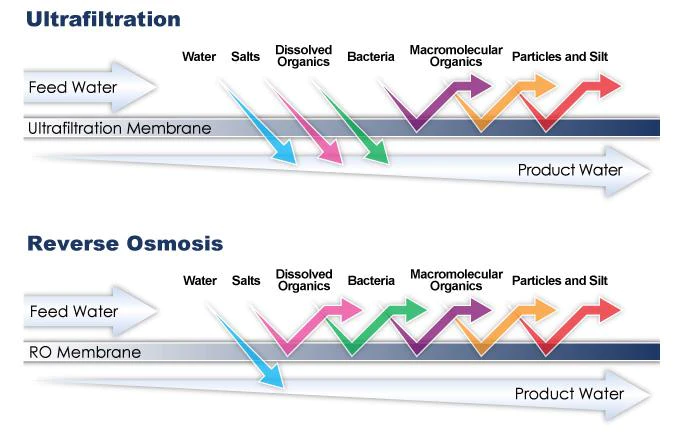No. Ultrafiltration (UF) and reverse osmosis (RO) are powerful and effective water treatment systems, but UF differs from RO in several important ways:
Filters out solids/particles as small as 0.02 microns, including bacteria. Cannot remove dissolved minerals, TDS and dissolved substances from water.
Produce water on demand – no storage tanks required
No waste water produced (water saving)
Runs smoothly at low voltage – no electricity required
What is the difference between ultrafiltration and reverse osmosis?
Membrane technology type
Ultrafiltration only removes particles and solids, but it does so at a microscopic level; the membrane pore size is 0.02 microns. In terms of taste, ultrafiltration does retain minerals, which affects the taste of the water.
Reverse osmosis eliminates nearly everything in the water, including most dissolved minerals and dissolved solids. RO membranes are semipermeable membranes with a pore size of approximately 0.0001 microns. Therefore, RO water is almost “odorless” because it contains no minerals, chemicals, and other organic and inorganic compounds.
Some people like their water to have minerals (courtesy of UF), others like their water to be completely pure and odorless (courtesy of RO).
Ultrafiltration has a hollow fiber membrane, so it’s basically an ultra-fine level mechanical filter that blocks particles and solids.
Reverse osmosis is a process that separates molecules. It uses a semi-permeable membrane to separate inorganics and dissolved inorganics from water molecules.
Wastewater/Reject
Ultrafiltration does not produce wastewater (waste products) during the filtration process*
In reverse osmosis, there is cross-flow filtration through a membrane. This means that a stream of water (permeate/product water) enters the storage tank and a stream of water containing all contaminants and dissolved inorganics (waste) enters the drain. Typically, for every 1 gallon of reverse osmosis water produced, 3 gallons are sent to drainage.
Install
Installing a reverse osmosis system requires a few connections: water supply lines, wastewater discharge lines, storage tanks, and air gap faucets.
Installing an ultrafiltration system with flushable membranes (the latest in ultrafiltration technology*) requires a few connections: a feed supply line, a drain line for flushing the membranes, and a dedicated faucet (drinking water applications) or outlet supply line (whole house or commercial application).
To install an ultrafiltration system without flushable membranes, simply connect the system to the feed supply line and a dedicated tap (potable water) or outlet supply line (entire residential or commercial applications).
Which one is better, RO or UF?
Reverse osmosis and ultrafiltration are the most effective and powerful systems available. Ultimately, which one is better is a personal preference based on your water conditions, taste preferences, space, desire to save water, water pressure, etc.
There is the RO water purifier and UF water purifier for your choice.
Post time: Sep-11-2023

